|
Schinus terebinthifolia Raddi, Mem. Mat. Fis. Soc. Ital. Sci. Modena, Pt. Mem. Fis. 18: 399 1820. (Syn: Rhus schinoides Willd. ex Schult. (Unresolved); Rhus trijuga Poir. (Unresolved); Sarcotheca bahiensis Turcz.; Schinus antiarthriticus Mart. ex Marchand; Schinus mellisii Engl.; Schinus mucronulatus Mart.; Schinus terebinthifolia var. damaziana Beauverd; Schinus terebinthifolia var. raddiana Engl.);
Common name: Brazilian Pepper, Aroeira, Bahamian holly, christmas berry, Florida holly, pepper tree, pink pepper, rose pepper
S-Brazil (Parana, Rio Grande do Sul, Santa Catarina), Paraguay (Alto Parana,
Amambay, Caazapa, Canindeyu), Mauritius (I), La Runion (I), Rodrigues (I), South Africa (I), St. Helena (I), Benin (I), Mozambique (I), Namibia (I), trop. Africa (I), Angola (I), Guinea (I), Portugal (I), Spain (I), Gibraltar (I), Costa Rica (I), Australia (I) (Western Australia (I), Queensland (I)), Taiwan (I), Jamaica (I), Haiti (I), Dominican Republic (I), Puerto Rico (I), Bahamas (I), Honduras (I), Turks & Caicos Isl. (I), Panama (I), Ecuador (I), Mexico (I), Bolivia (I), Venezuela (I), Isla Margarita (I), Colombia (I), Cuba (I), Virgin Isl. (I) (Anegada (I), St. Croix (I), St. John (I)), Trinidad & Tobago (I), New Caledonia (I), Norfolk Isl. (I), Fiji (I), Marshall Isl. (I) (Kwajalein (I)), Southern Marianas (I) (Guam (I)), Bonin Isl. (I) (Chichijima (I)), Hawaii (I) (Midway Isl. (I), Kauai (I), Oahu (I), Molokai (I), Lanai (I), Maui (I), Hawaii Isl. (I)), India (I), Pakistan (I), Vietnam (I), Morocco (I), Algeria (I), Tunisia (I), Libya (I), Canary Isl. (I) (Gran Canaria (I)) as per Catalogue of Life; Schinus terebinthifolius is a species of flowering plant in the cashew family, Anacardiaceae, that is native to subtropical and tropical South America (southeastern Brazil, northern Argentina and Paraguay). It is found in the following states of Brazil: Alagoas, Bahia, Espírito Santo, Mato Grosso do Sul, Minas Gerais, Pernambuco, Paraná, Rio de Janeiro, Rio Grande do Norte, Rio Grande do Sul, Santa Catarina, São Paulo and Sergipe. Common names include Brazilian pepper, aroeira, rose pepper, and Christmasberry.[2] Brazilian pepper is a sprawling shrub or small tree, with a shallow root system, reaching a height of 7–10 m. The branches can be upright, reclining, or nearly vine-like, all on the same plant. Its plastic morphology allows it to thrive in all kinds of ecosystems: from dunes to swamps, where it grows as a quasi-aquatic plant.[3] The leaves are alternate, 10–22 cm long, pinnately compound with (3–) 5–15 leaflets; the leaflets are roughly oval (lanceolate to elliptical), 3–6 cm long and 2–3.5 cm broad, and have finely toothed margins, an acute to rounded apex and yellowish veins. The leaf rachis between the leaflets is usually (but not invariably) slightly winged. The plant is dioecious, with small white flowers borne profusely in axillary clusters. The fruit is a small red spherical drupe 4–5 mm diameter, carried in dense clusters of hundreds of berries.
There are two varieties:
Brazilian pepper is widely grown as an ornamental plant in frost-free regions of South America for its foliage and fruit. It is considered as a melliferous flower. Although it is not a true pepper (Piper), its dried drupes are often sold as pink peppercorns, as are the fruits from the related species Schinus molle (Peruvian peppertree). The seeds can be used as a spice, adding a pepper-like taste to food. They are usually sold in a dry state and have a bright pink color. They are less often sold pickled in brine, where they have a dull, almost green hue. Brazilian pepper is hard to control because it produces basal shoots if the trunk is cut. Trees also produce abundant seeds that are dispersed by birds and ants. It is this same hardiness that makes the tree highly useful for reforestation in its native environment but which enables it to become invasive outside of its natural range.[6] (From Wikipedia on 27.10.14)
12112011 RV 1: Please help, to identify this bush in the Japanese Garden of Rani Bagh, Mumbai…… Its about 10 feet tall and flowering at this time.
A feeling of Rutaceae family.
Rutaceae to me also …….. Clausena sp ?
It appears to be Bursera sp. (Burseraceae). It is supposed to yield an aromatic volatile oil like lavender. However, it needs confirmation. How about Schinus terebinthifolius ?? (Anacardiaceae Family). Leaves have a peppery-turpentiney smell when crushed. I think … got it correct. It looks like Schinus terebinthifolius of Anacardiaceae family. it is Schinus species for sure
Yes … Very good pictures.
ID request.. : 7 posts by 4 authors. Attachments (2).
Came across this climbing shrub at “Sagar Upvan, Mumbai”. Requesting for ID?
Could be some variety of Poison Sumac (Toxicodendron)… this plant can be Schinus molle L. Sp. Pl. 388, 1753; Almeida, Fl. Mah. 1: 291, 1996; Singh et al, Fl. Mah. St. 1: 584, 2000. Thanks … I was trying to get its ID for long time. Thanks for yr guidance. this plant i had collected from Sagar Upwan and i found it to be Schinus molle. if you can refer Alemida, Fl of Maharashtra, it wil be helpful I think it is Schinus terebinthifolia (Cultivated) only.
Looks different from images of Schinus mole as per
http://tropical.theferns.info/viewtropical.php?id=Schinus+molle
Schinus terebinthifolius from me. Schinus molle looks much different.
I have seen in California.
I have posted Schinus molle from California before.
Shrub for ID : Nasik : 14MAY19 : AK-12 : 3 posts by 2 authors. Attachments (2)
Seen at a cultivated garden in Nasik.
Schinus terebinthifolius of Anacardiaceae?
Looks close. Schinus terebinthifolius : For Validation : Nasik : 31JUL19 : AK-39 : 3 posts by 2 authors. Attachments (2)
Seen at a cultivated garden in Nasik.
For validation.
Yes. Small Tree For ID : Oman : 09OCT16 : AK-10 : 9 posts by 3 authors. Attachments (7)
Small tree seen outside a park in Sept.
Seems to be Anacardiaceae.
This looks very close to Schinus terebinthifolius of Anacardiaceae to me.
efi page on Schinus terebinthifolia
this is Schinus sps for sure.
Thanks for confirming Schinus.
The two Schinus Species seen by me are Schinus terebinthifolius and Schinus molle.
My pictures look close to the first.
Hope to get it validated.
Schinus molle has stragling branches, it is bushy in habit. where as the sps in Pic is a small tree.
Yes … What I meant is that Schinus molle, seen by me in California, is very different. The leaves are diff too.
This looks more like Schinus terebinthifolius.
Yes … It looks like a different species.
References:
|
Schinus terebinthifolia (Cultivated)
Updated on December 24, 2024






